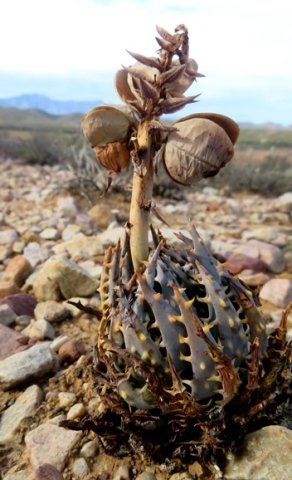Aloe longistyla

Aloe longistyla, commonly called ramenas or Karoo aloe, is a stemless, short-lived leaf succulent, in flower reaching heights around 20 cm.
The inflorescence is an unbranched, compact, cone-shaped raceme, sometimes occurring in pairs per rosette, simultaneously or successively. From 40 to 50 flowers are borne per raceme.
The tips of the congested buds are hooked upwards, the perianths curving up in their upper third. The orange-red or salmon-pink flowers ascend, their stamens well exserted.
The specific name, longistyla, refers to the long, conspicuously exserted style. This style becomes up to 7,5 cm long, the longest among South African aloes.
The species is distributed in the Great Karoo and the Little Karoo in the Western Cape and Eastern Cape from Calitzdorp where the photo was taken to Laingsburg, Middelburg, Cradock and inland from Grahamstown.
The habitat is Nama Karoo and succulent Karoo where the plants grow scattered in arid, karoid scrubland. They take to loam or sandy soils on stony flats and gentle slopes under bigger plants, typically Karoo bushes. The plants cope with wide temperature variations and low (mainly summer) rainfall.
It is unclear how this Aloe is faring in nature early in the twenty first century, due to data deficiency concerning the extent of livestock grazing (in some places overgrazing) in its habitat and plant numbers involved in collections.
Although people too often remove these aloes from their habitat, the plants do not perform well in cultivation, causing unnecessary plant deaths (Vlok and Schutte-Vlok, 2010; Van Wyk and Smith, 2003; Reynolds, 1974; Jeppe, 1969; http://redlist.sanbi.org).

